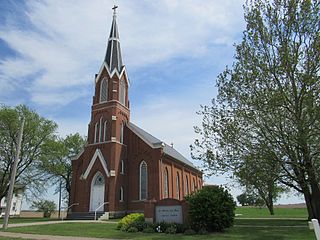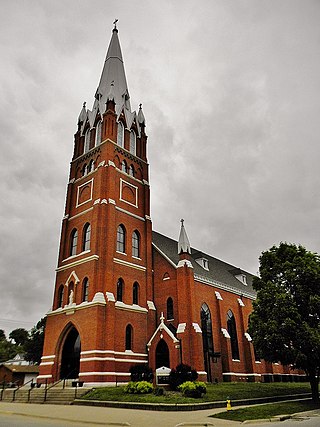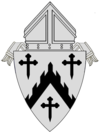
The Metropolitan Archdiocese of Dubuque is a Latin Church ecclesiastical territory or archdiocese of the Catholic Church in the northeastern quarter of the state of Iowa in the United States.

The Diocese of Davenport is a Latin Church ecclesiastical jurisdiction, or diocese, of the Catholic Church for the southeastern quarter of the state of Iowa in the United States.

Sacred Heart Cathedral, located in Davenport, Iowa, United States, is a Catholic cathedral and a parish church in the Diocese of Davenport. The cathedral is located on a bluff overlooking the Mississippi River to the east of Downtown Davenport. It is listed on the National Register of Historic Places as part of the Sacred Heart Roman Catholic Cathedral Complex. This designation includes the church building, rectory, and the former convent, which was torn down in 2012. The cathedral is adjacent to the Cork Hill Historic District, also on the National Register. Its location on Cork Hill, a section of the city settled by Irish immigrants.

Henry Patrick Rohlman was a German-born prelate of the Roman Catholic Church. He served as bishop of the Diocese of Davenport in Iowa from 1927 to 1944 and as coadjutor archbishop and archbishop of the Archdiocese of Dubuque in Iowa from 1944 to 1954.
Aloysius Joseph Schulte (1858–1940) was an American Catholic academic who served as the first president of St. Ambrose College in Davenport, Iowa, from 1882 to 1891.

St. Ambrose Cathedral is a historic building located in downtown Des Moines, Iowa, United States. It serves as a parish church and as the seat of the Diocese of Des Moines in the Catholic Church. The cathedral, along with the adjoining rectory, was listed on the National Register of Historic Places in 1979.

Henry Cosgrove was a late 19th-century and early 20th-century bishop of the Catholic Church in the United States. He served as the second bishop of Diocese of Davenport in Iowa from 1884 to until his death in 1906.

St. Mary's Catholic Church, also known as St. Mary of the Visitation Church, is a parish church of the Diocese of Davenport which is located in Iowa City, Iowa, United States. The church building and rectory were listed together on the National Register of Historic Places in 1980. They were both included as contributing properties in the Jefferson Street Historic District in 2004. The parish's first rectory, which is now a private home, is also listed on the National Register as St. Mary's Rectory. It is located a few blocks to the east of the present church location at 610 E. Jefferson St.

James Joseph Davis was an Irish-born prelate of the Roman Catholic Church. He served as the third bishop of the Diocese of Davenport in Iowa from 1906 to until his death in 1926.

St. Anthony's Catholic Church is a parish church in the Diocese of Davenport. The parish complex is located in downtown Davenport, Iowa, United States, at the corner of Fourth and Main Streets. It is the first church congregation organized in the city of Davenport and the second Catholic congregation, after St. Raphael's in Dubuque, in the state of Iowa. The parish buildings were listed on the National Register of Historic Places as St. Anthony's Roman Catholic Church Complex in 1984. The designation includes the church and the former school building, which is the parish's original church building and the oldest standing church building in Iowa. The designation also included the rectory, which was partially torn down in 2009. The complex was also listed on the Davenport Register of Historic Properties in 1992 as St. Anthony's Church Square. The property has been known historically as Church Square. In 2020 the parish buildings, except for the parish center, were included as contributing properties in the Davenport Downtown Commercial Historic District. Because of its recent construction date, the parish center is excluded as a contributing property.

St. Mary's Catholic Church was a parish of the Diocese of Davenport. The church building is located in the west end of Davenport, Iowa, United States, at the corner of Fillmore and W. 6th Streets. It is listed on the National Register of Historic Places as St. Mary's Roman Catholic Church Complex. The designation includes the church building and rectory on the west side of Fillmore Street, and the former parochial school building and convent on the east side. A former school building operated by the parish two blocks north on West Eighth Street is also on the National Register and is listed as St. Mary's Academy. The parish ceased operations in July 2020 when it was merged into St. Anthony's Church downtown. The parish campus is being acquired by the nonprofit organization Humility Homes & Services, which is operated by the Congregation of the Humility of Mary.

Saints Peter and Paul Roman Catholic Church is a former parish church of the Diocese of Davenport. The church is located southeast of Harper, Iowa, United States, in Clear Creek Township, Keokuk County. The church building was individually listed on the National Register of Historic Places in 1986. The parish property was listed as a historic district in 2021. The parish was known in the Davenport Diocese as Saints Peter and Paul, Clear Creek.

St. Joseph's Catholic Church is a former parish of the Diocese of Davenport. The church is located in Dallas township in rural Marion County, Iowa, United States. It was part of the now defunct village of Bauer. The closest communities are Melcher-Dallas and Lacona. The church building still stands and together with the adjacent cemetery comprises an historic district listed on the National Register of Historic Places.

St. Mary's Catholic Church is a parish church of the Diocese of Davenport. The church is located at the corner of St. Mary's and Washburn Streets in the town of Riverside, Iowa, United States. The entire parish complex forms an historic district listed on the National Register of Historic Places as St. Mary's Parish Church Buildings. The designation includes the church building, rectory, the former church, and former school building. The former convent, which was included in the historical designation, is no longer in existence.

Holy Family Catholic Church is a parish of the Diocese of Davenport. The parish is the result of a merger between Saints Mary and Joseph Parish and Sacred Heart Parish in the city of Fort Madison, Iowa, United States. It maintains both of the former parish church buildings as worship sites. The oldest parish in town, St. Joseph, and St. Mary of the Assumption had merged in the 1990s. St. Mary of the Assumption Church, which became Saints Mary and Joseph, is located at 11th Street and Avenue E. It was individually listed on the National Register of Historic Places in 1980. Sacred Heart Church is located at 23rd Street and Ave I.
John George Alleman was a missionary Catholic priest who served in the states of Ohio, Iowa and Illinois. He served as a priest in the Dominican Order from 1834 to 1840, after which time he was expelled from the order. He then served as a secular priest in the Diocese of Dubuque from 1840 to 1851, and in the Diocese of Chicago from 1851 to 1863. During his hospitalization in St. Louis, Missouri, (1863–1865) he was accepted back into the Dominican Order.

St. Boniface Catholic Church is a parish of the Diocese of Des Moines. The church is located in Westphalia, Iowa, United States, and the parish plant is listed on the National Register of Historic Places as Saint Boniface Catholic Church District. At the time of its nomination the district consisted of 16 resources, including six contributing buildings, one contributing structure, two contributing sites, one contributing object, six noncontributing buildings, and one noncontributing object.

St. Paul's Catholic Church is a historic church building located in Burlington, Iowa, United States. Together with the Church of St. John the Baptist in Burlington and St Mary's Church in West Burlington it forms Divine Mercy parish, which is a part of the Diocese of Davenport. The parish maintains the former parish church buildings as worship sites. St. Paul's Church and the rectory are contributing properties in the Heritage Hill Historic District listed on the National Register of Historic Places. St. Paul's School was also a contributing property in the historic district, but it has subsequently been torn down.

The St. Joseph's Church Complex is a collection of historic buildings located in Fort Madison, Iowa, United States. At one time the complex housed a Catholic parish in the Diocese of Davenport. St. Joseph and St. Mary of the Assumption parishes merged in the 1990s to form Saints Mary and Joseph Parish. In 2007 when that parish merged with Sacred Heart on the west side to form Holy Family Parish, St. Joseph's Church was closed. The former church, chapel, rectory, convent, and school were included as contributing properties in the Park-to-Park Residential Historic District that was listed on the National Register of Historic Places in 2014.

St. Anthony's Catholic Church is a Catholic parish church in the Diocese of Des Moines located on the south side of Des Moines, Iowa, United States. It was listed on the National Register of Historic Places in 2021.





















